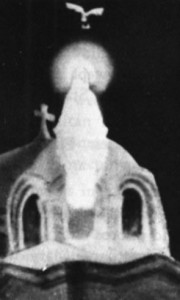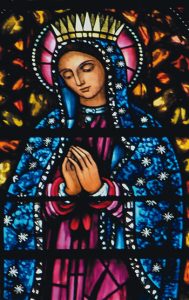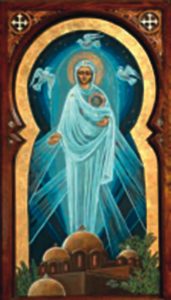Mary for Today: Mary and Apparitions (2)
We need to examine the question of apparitions, or more precisely, the attitude we take to them. Some have been recognised by the Church and have become very important places of pilgrimage. Others have become sites for the celebration of significant events attributed to Mary. Popular piety regards these sanctuaries as places where people love to pray, where the Gospel is preached to great crowds, where the sick are comforted, and many conversions take place. On the other hand, the question of Marian apparitions presents itself with a new urgency in our day with several sites awaiting the Church’s definitive and official judgment.
What is the meaning of Marian apparitions?
We do not attribute the same significance to recognised apparitions such as Lourdes and Fatima as we do to ‘presumed’ apparitions not recognised by the Church. Between 1928 and 1971 there were no fewer than 210 apparitions, none of which were recognised by the Church. Extreme prudence is required in light of mysterious or marvellous phenomena and the proliferation of signs and secrets from one apparition to another. Pope Benedict XIV (1740-1758) made the position very clear: “It is necessary to know that the approval given by the Church … is nothing other than giving permission, after careful examination, to make known a particular revelation for the instruction and welfare of the faithful. Even if approved, one should not, and cannot assign universal consent.”
Nothing is to be imposed -- they are a sign and not a proof, and can help some people in their faith. They are neither indispensable nor central to adhering to the faith. As Christians, no one is dispensed from following the Gospel, but neither is anyone obliged to believe in Lourdes, Fatima, or Medjugorje. Apparitions must lead back to the Gospel, the unique and indispensable source of all preaching on Mary, of all Marian spirituality, and of the teaching of tradition. Today’s fascination with Marian apparitions should stimulate us to look for a solid foundation from which to nourish our faith.
Message:
Major documents from the Magisterium, Vatican II, Paul VI, and John Paul II have chosen to base their reflections on the Bible. The path then is laid out for us to rediscover Mary by starting with the Gospel – the path followed since the beginning of these reflections on Mary. Rather than basing everything on the ‘marvellous’, we must return to the Gospel and put all of our strength into the mission of evangelising.
At Lourdes in 1986 the Archbishop of Tours spoke these words: “I would like to share a conviction. The best antidote for this appetite for the marvellous and for revelation is the direct and effective participation in the mission of the Church. A Christian who studies the teaching of the Church … will not be encumbered with new revelations; the Gospel and the Creed are enough.”
Some Salutary Lessons from Apparitions:
Some apparitions have an appeal that links powerfully into the Scriptures. A favourite of mine is Guadalupe, and here is why. It all began in Genesis 10 with the table of the nations, all descended through the three sons of Noah. When Columbus bumped into the Americas (and, incidentally, his flagship was named the ‘Santa Maria’) he never imagined that his new undertaking would affect the world of the Bible, in addition to the political, economic, cultural and ethical factors. Those people he ‘found’ were not Asian, raising the question of literal interpreters, whether they could be considered part of the truly human family, unless the Bible was mistaken.
In 1531 an unexpected factor emerged to help solve the problem. The issue concerned the strange beings with coppery skin, half-naked, who communicated in an incomprehensible language, who lived in a primitive state. Did these people have authentic human souls? Were they also deserving of Christ’s redemption? Meanwhile on the slopes of Tepeyac, near Mexico City, the Indio Juan Diego received a vision of a lady, the virgin of Guadalupe, who left her image as an Indian, with dark skin, large eyes, and endowed with native features, imprinted on a mantle.
Unashamedly, the Mother of God acknowledged as her children those whom the European community had difficulty accepting as their brothers and sisters. Six years later Pope Paul III wrote a solemn letter, Sublimis Deus, giving the definitive opinion of the Church: “the Indians are (to be seen as) real human beings and capable of receiving the Catholic faith … not to be enslaved nor induced to embrace the Catholic faith by means other than the proclamation of the divine word and a holy life.”
And so it was that Our Lady of Guadalupe opened the ‘list of nations’ to the Americas and like her Son showed her concern for the poor and exploited on the face of the earth. This has been forcefully placed before us by Pope Francis, but there is a second message coming from him, that of better dialogue between Christian denominations as well as between great world religions, notably Islam.
Our Lady of Zeitoun:
And that takes me to less well known apparition. Our Lady of Zeitoun, also known simply as El-Zeitoun, Zeitun or rarely Our Lady of Light, was a mass Marian apparition that occurred in Cairo, Egypt, over a period of 2–3 years beginning in April 1968.
The first apparition at Zeitoun was recorded on the evening of April 2, 1968 when a Muslim bus mechanic named Farouk Mohammed Atwa, who worked across the street from the church of Saint Mary in Zeitoun, thought he saw a woman attempting suicide by jumping from the structure. Two other men also noticed a white figure on the top of the church and the sighting was reported to the police.
A crowd gathered on the site and the police attempted to disperse it. According to the police, the sighting was just a reflection of the light from the street lamps. However, the crowds reportedly viewed the sighting as a clear apparition of Saint Mary, and so, the attempts by the police to disperse the crowd were unsuccessful. The event itself ended after a few minutes.
One week later on April 9 the phenomenon reoccurred, again lasting for only a few minutes. After that time apparitions became more frequent, sometimes two-three times a week, for several years, ending in 1971. Many healings and miracles were reported during the time of the apparitions.

An apparition of Mary at Saint Mark’s Coptic Church, Zeitoun. There were many apparitions at this site dedicated to the Holy Family. Large crowds gathered, sometimes up to 250,000 people.
The apparitions of Our Lady of Assiut were also mass apparitions in Assiut, Egypt, during 2000 and 2001 and many thousands of witnesses produced photographs of them, which were reprinted in several newspapers. The reports state that during Mass, pictures hung on the wall inside the altar, which show St Mary with a dove above her, started to illuminate first, then the light from the dove in the pictures started to flow down. The lights thereafter appeared above the church as well and were seen by thousands of people. The Coptic Church approved both of the apparitions but the Roman Catholic Church still walks a cautious path with regard to approval.



 Entries(RSS)
Entries(RSS)